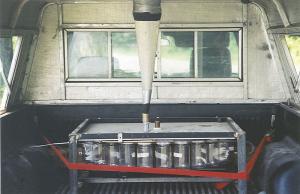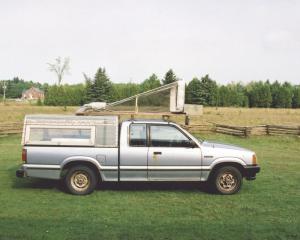2012 - Volume #36, Issue #3, Page #44
[ Sample Stories From This Issue | List of All Stories In This Issue | Print this story
| Read this issue]
"Fly Guy" Hits Road With Pickup-Mounted Net
 |
 |
The Trent University entomology professor and researcher – known as the Fly Guy among local Ontario farmers – wants to catch bugs when traveling down farm roads. So, he made a big net out of 1-in. conduit and black mosquito netting secured with lamp wick seams, and he secured it to the top of his truck. The back of the net connects to a large flue pipe duct-taped to a funnel that drops captured insects into 1/2-liter plastic bottles on a carousel under the pickup topper. Made of plywood, 1-in. angle iron and an old dryer bearing, Beresford can turn the carousel with a lever and bike cable from inside the cab. His scientific approach is to change bottles every five kilometers to determine where stable flies are and hopefully help predict when they will arrive at area farms.
“It’s important to control them in a way that’s thrifty. If you’re not thrifty you kill the wrong insects, and you waste money and don’t get any benefit,” Beresford says.
He explains that stable flies resemble houseflies, but they have a bayonet for a mouth to bite cattle on the legs and suck blood. That riles the cattle and affects weight gain and milk production. A Nebraska study estimates the stable fly costs U.S. dairy and beef producers $2.4 billion annually.
In addition to studying effective traps to capture stable flies, Beresford gathers flies in a 30-square mile area and combines that information with weather and temperature. By determining the number of growing degree days before they arrive, farmers could begin eradicating them earlier when the numbers (and eggs) are fewer.
Another thing Beresford looks for are mites on the flies. Mites are good, he says, as they will eat many of the eggs the flies lay and reduce the numbers of flies on a farm.
To kill the flies, Beresford makes traps made of corrugated plastic covered with white fabric netting sprayed with 1/10 mix of Ectiban and water. The key is to place them low (about 12 in. above vegetation), where stable flies travel. Commercial sticky traps should be set up about 8 in. above short grass and 9 1/2 in. above tall grass. Dairy farmers, who use spray, apply it at ankle height to target the biting stable flies and not the non-biting flies that fly at a higher level. Beresford notes that sprays do kill flies, but they also kill the beneficial mites, so he prefers traps.
“I’m against wasting money and not killing the target. You should use spray like a rifle, not a shotgun,” Beresford says.
Reduce breeding areas by keeping bedding and manure as dry as possible. In warmer areas where flies can overwinter, throw out wet bedding around waterers and stock tanks in the winter. In the spring, remove wet organic matter to prevent the flies from hatching.
Beresford says he’s grateful for the farmers who have allowed him to do his real world research. His goal is to get information to as many producers as possible. Driving around in a truck with a big net may only gather 10 to 15 stable flies at a time, but it also attracts media attention that helps spread results of his research.
Contact: FARM SHOW Followup, David Beresford, PhD, Assistant Professor Biology Department, Trent University, 1600 West Bank Dr., Peterborough, Ont. K9J 7B8 Canada (ph 705 748-1011, ext. 7540; davidberesford@trentu.ca).

Click here to download page story appeared in.

Click here to read entire issue
To read the rest of this story, download this issue below or click here to register with your account number.




